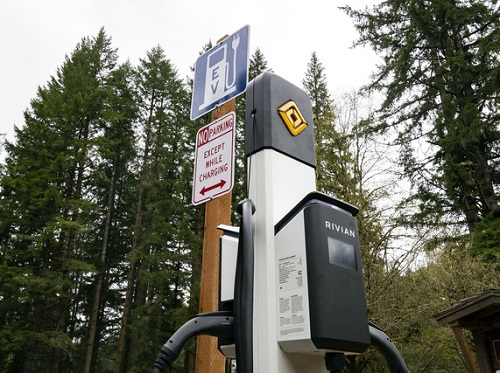The Oregon Department of Transportation is spending $1.75 million to help companies, schools, apartment building owners, small towns, and other groups build 370 new public Level 2 electric vehicle or EV charging ports in rural and disadvantaged areas.
[Above photo by the Oregon DOT]
The Community Charging Rebates Program is one way Oregon DOT is trying to beef up the state’s EV charging infrastructure to simultaneously encourage and meet the demand for zero-emission vehicles to reduce greenhouse gas emissions. A 2022 Oregon DOT study noted that the state will need about 17,000 Level 2 charging ports by 2025 to meet a goal of 250,000 registered EVs in the state.
Under the program, which is 100 percent state funded, organizations can get rebates of up to 75 percent of the cost of buying and installing EV charging stations at multifamily homes and public parking areas. ODOT reserved 70 percent of the first funding round to applicants who would build EV charging stations in rural or disadvantaged communities.
“Some sections of the state have EV charging gaps,” noted Oregon DOT spokesman Matt Noble. “These are populations we serve that haven’t seen the level of EV infrastructure investment as other areas.”
Of the 94 projects receiving awards via this program, 79 are in rural or disadvantaged communities, according to an agency statement. Noble added the response to the program was “overwhelmingly positive,” so Oregon DOT plans to do a second round of funding in March 2024.
The money for the Community Charging Rebates program is from a $100 million federal-state fund the Oregon Transportation Commission created in 2022 to build out the EV charging infrastructure. Most of that money is going toward Alternative Fuel Corridors; routes approved by the Federal Highway Administration where states may use federal funding to build alternative fuel infrastructure. In Oregon, those routes include seven interstate highways.
The remaining $36 million – all state cash – is being used to build charging stations in places that are not along those corridors. By growing the charging infrastructure in those areas, the Oregon DOT is hoping to overcome one of the biggest hurdles to EV ownership: range anxiety.
Oregon has more than doubled the number of registered EVs in the state since 2020, from less than 23,000 to about 51,000, according to statistics from the Oregon Department of Energy. There are about 2,800 Level 2 and fast-charging ports across the state, a ratio of one port for every 18 vehicles.
That’s fewer than the national average of about 15 vehicles per port, according to data from the U.S. Department of Energy.
For a broader look at EV infrastructure advancement, the Alternative Fuels Data Center – operated by the DOE – maintains state-by-state information on the number and types of EV stations and ports, as well as a breakdown of all alternative fuel stations, such as biodiesel and propane.
Other state departments of transportation are also engaging in efforts to build out EV support infrastructure.
For example, the Utah Department of Transportation recently announced plans to double the state’s current fast charging capacity for electric vehicles by the end of 2024 with the addition of 15 new sites funded through the $5 billion National Electric Vehicle Infrastructure or NEVI Formula Program launched in 2022.
Since 2015, the agency said the number of EVs in Utah has grown by an average of 48 percent year over year – and the rate of growth is climbing. To meet this increasing need, the Utah DOT – together with the Utah Office of Energy Development – identified 15 strategic sites for EV fast chargers on major state roads. In response, private entities submitted 75 applications to match their private fund with NEVI funding.
Meanwhile, the Maryland Department of Transportation introduced a new tool in June to help local governments and agencies dip into $2.5 billion in federal grants to build an electric vehicle or EV charging network.
The agency’s EV Charger Siting Tool is a map-based website that helps the user select those communities and charging sites in Maryland that have the best chance of securing grants under Federal Highway Administration’s Charging and Fueling Infrastructure or CFI discretionary grant program, funded by the $1.2 trillion Infrastructure Investment and Jobs Act or IIJA enacted in November 2021.
The tool consolidates geographic data on existing chargers, registered EV users, disadvantaged communities, alternative fuel corridors, and “marginalized and underserved communities targeted for investment to address climate change and clean energy needs,” the Maryland DOT noted.

